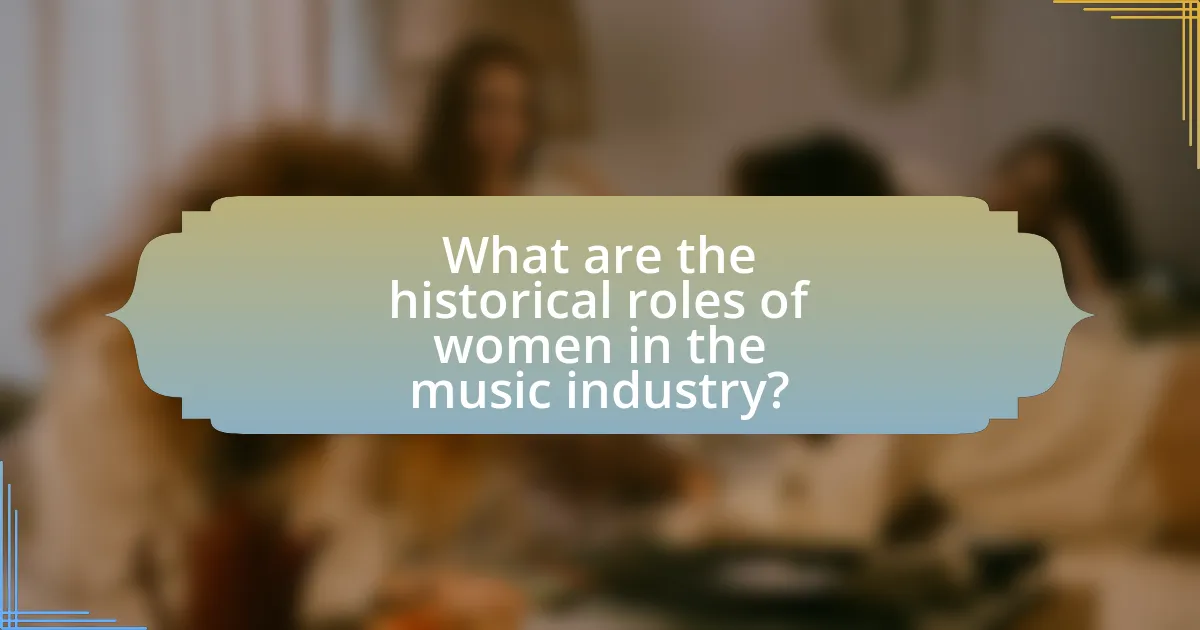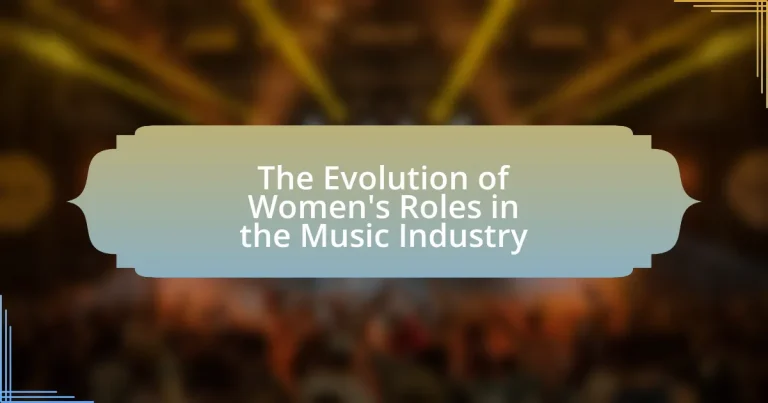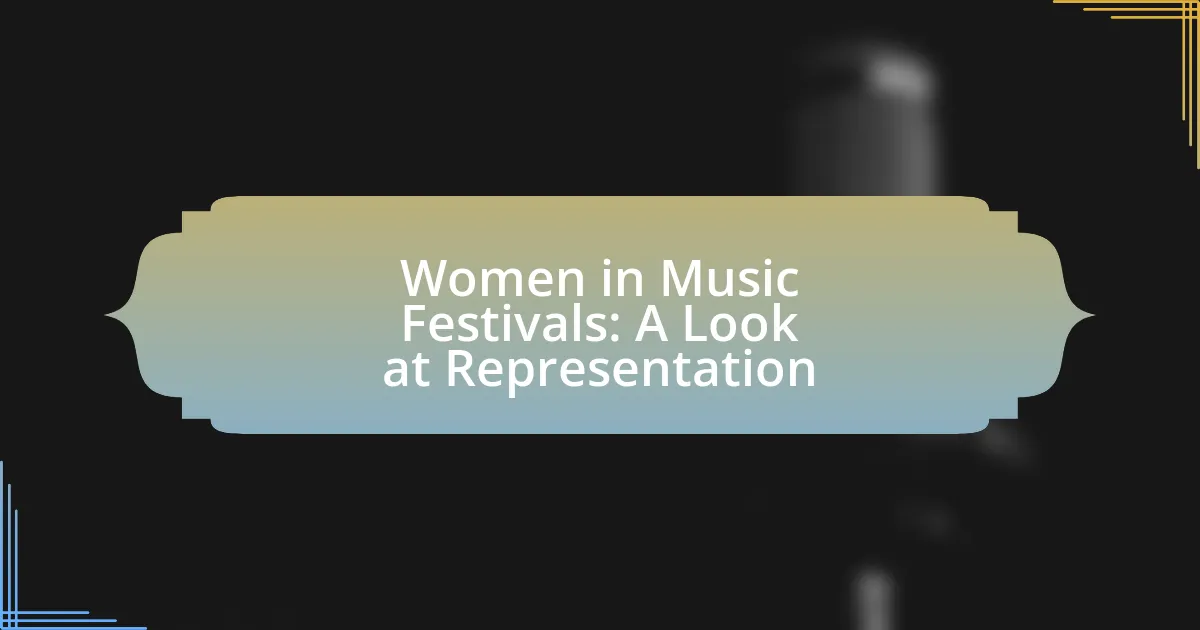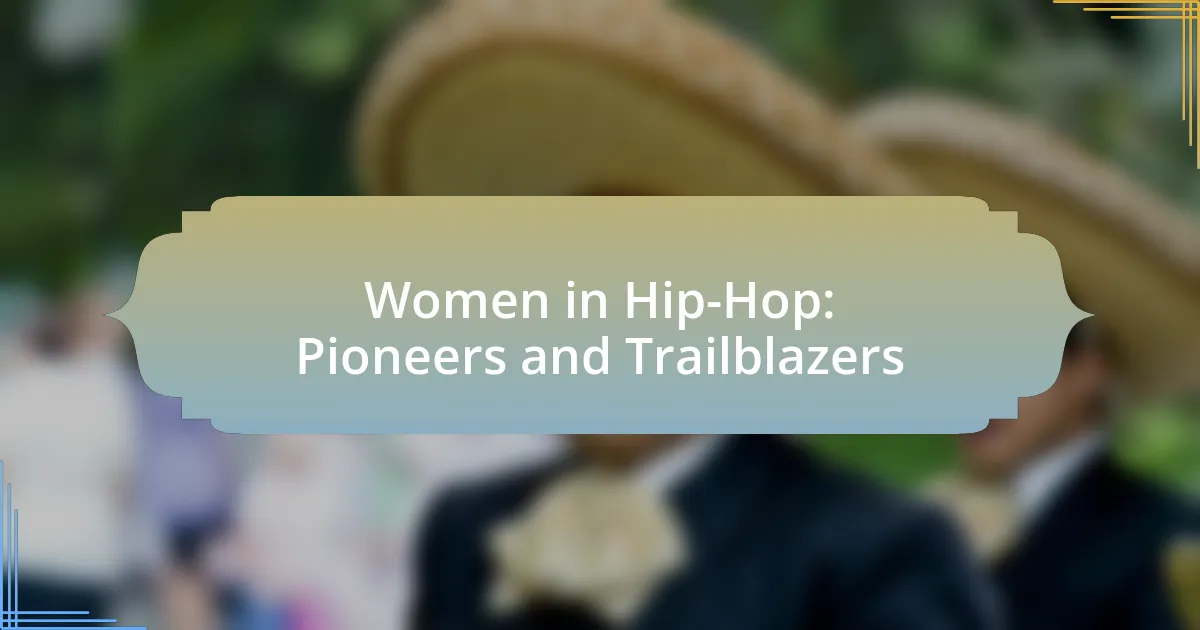The article examines the evolution of women’s roles in the music industry, highlighting their historical contributions as performers, composers, and producers while addressing the barriers they have faced due to gender discrimination. It traces the progression from the 19th century, where women primarily occupied roles as performers and educators, to the emergence of influential figures in jazz and blues, and the significant milestones achieved in the 20th and 21st centuries. The discussion includes the impact of societal norms, gender stereotypes, and key movements that have shaped women’s representation in music, as well as current trends and challenges they continue to encounter today. Additionally, it outlines practical steps and resources available to support aspiring female musicians in navigating the industry effectively.

What are the historical roles of women in the music industry?
Historically, women in the music industry have played diverse roles, including performers, composers, and producers, often facing significant barriers due to gender discrimination. In the early 20th century, women like Ma Rainey and Bessie Smith emerged as influential blues singers, paving the way for future generations. During the 1960s and 1970s, artists such as Aretha Franklin and Janis Joplin challenged societal norms and expanded the representation of women in popular music. By the late 20th century, women began to take on more behind-the-scenes roles, with figures like Sylvia Rhone and Clive Davis highlighting women’s contributions to music production and management. This evolution reflects a gradual shift towards greater recognition and empowerment of women in the industry, evidenced by the increasing number of female artists and executives in contemporary music.
How have women’s roles evolved from the early days of music?
Women’s roles in music have evolved from being primarily passive participants or muses to becoming influential creators, performers, and industry leaders. In the early days of music, women were often relegated to roles such as singers in domestic settings or performers in limited public venues, with few opportunities for composition or leadership. Over time, particularly from the late 19th century onward, women began to gain recognition as composers and instrumentalists, exemplified by figures like Clara Schumann and Amy Beach. The 20th century saw a significant shift, with women like Billie Holiday and Aretha Franklin not only achieving commercial success but also using their platforms to advocate for social change. By the 21st century, women have taken on diverse roles in the music industry, including producers, executives, and festival organizers, reflecting a broader societal recognition of gender equality and women’s contributions to music. This evolution is supported by statistics showing increased representation of women in music festivals and awards, indicating a significant shift in the industry’s landscape.
What were the primary roles women held in music during the 19th century?
During the 19th century, women primarily held roles as performers, composers, and educators in music. As performers, many women gained recognition in concert settings, often as vocalists or pianists, with figures like Clara Schumann exemplifying this role. In composition, women such as Fanny Mendelssohn and Amy Beach contributed significantly to the repertoire, despite societal constraints. Additionally, women served as music educators, teaching in private settings and institutions, which helped to establish music education as a respected profession for women. These roles were crucial in shaping the landscape of music during this period, reflecting both the talents of women and the evolving societal attitudes towards their participation in the arts.
How did the emergence of jazz and blues influence women’s participation in music?
The emergence of jazz and blues significantly increased women’s participation in music by providing them with new opportunities for performance and expression. During the early 20th century, genres like jazz and blues became platforms where women could showcase their talents, often as vocalists or instrumentalists, breaking traditional gender roles in the music industry. Notable figures such as Bessie Smith and Billie Holiday gained prominence, demonstrating that women could achieve fame and success in a male-dominated field. This shift was further supported by the rise of nightclubs and radio, which allowed female artists to reach wider audiences and gain recognition. The cultural acceptance of these genres also contributed to a broader societal change, encouraging more women to pursue careers in music.
What barriers have women faced in the music industry over time?
Women in the music industry have historically faced barriers such as gender discrimination, lack of access to opportunities, and underrepresentation in key roles. Gender discrimination has manifested in the form of unequal pay, with studies indicating that female musicians often earn significantly less than their male counterparts; for instance, a 2019 report by the USC Annenberg Inclusion Initiative found that only 22.4% of artists on the Billboard Hot 100 were women. Additionally, women have encountered challenges in gaining visibility and recognition, as evidenced by their underrepresentation in music festivals and award nominations. The lack of female representation in production and executive roles further limits women’s influence and opportunities within the industry, with only 2% of producers being women according to a 2020 report by the Music Industry Research Association. These barriers have persisted over time, impacting women’s ability to thrive and succeed in the music industry.
What societal norms have impacted women’s roles in music?
Societal norms have significantly impacted women’s roles in music by enforcing traditional gender roles and limiting opportunities for female musicians. Historically, women were often relegated to domestic roles, which restricted their participation in public performance and composition. For instance, in the 19th century, societal expectations dictated that women should focus on family and home, leading to a lack of representation in professional music settings. Additionally, the perception of women as less capable than men in creative fields has perpetuated barriers, resulting in fewer women being signed to record labels or receiving recognition for their work. Research indicates that female artists often face challenges such as gender bias and sexual objectification, which further complicate their roles in the industry. These societal norms have created an environment where women’s contributions to music are frequently undervalued, impacting their visibility and success.
How have gender stereotypes affected women’s opportunities in the industry?
Gender stereotypes have significantly limited women’s opportunities in the music industry by perpetuating biases that favor male dominance in creative and leadership roles. For instance, studies show that women are often underrepresented in key positions such as producers and executives, with only 2% of producers being women in 2019 according to the Annenberg Inclusion Initiative. This disparity restricts women’s access to influential networks and resources, ultimately hindering their career advancement. Additionally, stereotypes that portray women as less competent or overly emotional contribute to a culture that undervalues their contributions, further entrenching gender inequality in the industry.
What significant milestones have marked women’s progress in the music industry?
Significant milestones that have marked women’s progress in the music industry include the emergence of female artists in the 1920s jazz scene, the rise of women in rock music during the 1960s and 1970s, and the increasing presence of women in leadership roles within music organizations. For instance, in 1920, Bessie Smith became one of the highest-paid black performers, paving the way for future generations. In the 1970s, artists like Janis Joplin and Stevie Nicks broke gender barriers in rock music, leading to greater acceptance of female musicians. Additionally, the appointment of women to executive positions, such as Sylvia Rhone becoming the first female president of a major record label in 1994, has further advanced women’s roles in the industry. These milestones collectively illustrate the evolving landscape for women in music, highlighting their contributions and influence over time.
What key movements have supported women’s advancement in music?
Key movements that have supported women’s advancement in music include the feminist movement, the women’s liberation movement, and the rise of female empowerment initiatives within the music industry. The feminist movement, particularly in the 1960s and 1970s, advocated for gender equality and challenged the male-dominated music industry, leading to increased visibility and opportunities for female artists. The women’s liberation movement further emphasized women’s rights and autonomy, encouraging women to pursue careers in music and express their identities through their art. Additionally, initiatives like the establishment of organizations such as Women in Music and the creation of awards recognizing female talent have provided platforms for women to succeed and be acknowledged in the industry. These movements collectively contributed to a cultural shift that has allowed women to gain greater representation and influence in music.
How did the feminist movement influence women’s roles in music during the 1970s?
The feminist movement significantly influenced women’s roles in music during the 1970s by promoting gender equality and encouraging female artists to assert their identities and creativity. This era saw the emergence of female musicians who challenged traditional gender norms, such as Joan Baez and Joni Mitchell, who used their platforms to address social issues and advocate for women’s rights. The establishment of organizations like the Women’s Music Festival and the rise of all-female bands, such as The Runaways, further exemplified this shift, as they provided spaces for women to perform and express themselves. Additionally, the feminist movement’s emphasis on self-expression and empowerment led to an increase in female songwriters and producers, reshaping the music industry landscape and paving the way for future generations of women in music.
What impact did the rise of female artists in the 1990s have on the industry?
The rise of female artists in the 1990s significantly transformed the music industry by increasing visibility and representation of women across various genres. This shift led to a diversification of musical styles and themes, as artists like Alanis Morissette, TLC, and Shania Twain challenged traditional gender roles and addressed issues such as empowerment, sexuality, and personal struggles in their lyrics. The success of these artists contributed to a surge in female-led record labels and initiatives aimed at promoting women in music, evidenced by the establishment of organizations like Women in Music in 1985, which gained momentum in the 1990s. Furthermore, the commercial success of female artists during this decade, with Morissette’s “Jagged Little Pill” selling over 33 million copies worldwide, demonstrated the market demand for female voices, prompting record labels to invest more in female talent.
What notable achievements have women accomplished in the music industry?
Women have achieved significant milestones in the music industry, including breaking barriers in various genres and holding influential positions. For instance, women like Aretha Franklin and Whitney Houston have set records for the most Grammy Awards won by a female artist, with Franklin winning 18 and Houston winning 6, showcasing their impact on music and culture. Additionally, women such as Taylor Swift and Beyoncé have not only dominated the charts but also influenced industry practices, with Swift advocating for artists’ rights regarding streaming royalties and Beyoncé’s visual album “Lemonade” redefining the music video format. Furthermore, women have increasingly taken on leadership roles, with figures like Sylvia Rhone becoming the first female CEO of a major record label, Epic Records, in 2018, highlighting the growing presence of women in executive positions within the industry.
Which women have broken records or achieved significant recognition in music?
Beyoncé, Taylor Swift, and Adele are women who have broken records and achieved significant recognition in music. Beyoncé holds the record for the most Grammy Awards won by a female artist, with 28 wins as of 2023. Taylor Swift became the first woman to win the Album of the Year Grammy three times, and her album “Folklore” broke streaming records upon release. Adele’s album “21” is one of the best-selling albums of all time, with over 31 million copies sold worldwide, and she has won 15 Grammy Awards. These achievements highlight the substantial impact women have made in the music industry.
How have women contributed to various music genres and styles?
Women have significantly contributed to various music genres and styles by shaping the sound, culture, and direction of music throughout history. In genres such as rock, artists like Joan Jett and Stevie Nicks broke barriers, influencing the genre’s evolution and paving the way for future female musicians. In pop music, icons like Madonna and Beyoncé have not only dominated the charts but also redefined the role of women in performance and production, showcasing empowerment and artistic control. In jazz, figures like Billie Holiday and Ella Fitzgerald set standards for vocal excellence and improvisation, influencing countless artists. Additionally, women in hip-hop, such as Missy Elliott and Nicki Minaj, have expanded the genre’s boundaries, addressing social issues and personal narratives. Their contributions are evidenced by numerous awards, chart-topping hits, and their roles as cultural icons, demonstrating the profound impact women have had across all music genres.
How do contemporary women’s roles in the music industry compare to the past?
Contemporary women’s roles in the music industry are significantly more diverse and empowered compared to the past. Historically, women were often relegated to supporting roles or faced barriers to entry, with limited opportunities for creative control and recognition. In contrast, recent statistics indicate that women now comprise approximately 30% of artists in the Billboard Hot 100, a notable increase from previous decades when their presence was minimal. Additionally, women are increasingly taking on leadership roles, with a growing number of female producers, songwriters, and executives in major record labels, reflecting a shift towards greater gender equality in the industry. This evolution is further evidenced by the success of female-led movements and initiatives aimed at promoting women’s visibility and influence in music, such as the #MeToo movement and organizations like Women in Music, which advocate for equal representation and opportunities.
What current trends are shaping women’s roles in the music industry today?
Current trends shaping women’s roles in the music industry include increased representation in leadership positions, the rise of female-led music festivals, and the growing influence of social media platforms. Women are now occupying more executive roles within record labels and music organizations, which has been evidenced by a 2021 report from the Annenberg Inclusion Initiative that found women held 23.3% of executive roles in the music industry, a notable increase from previous years. Additionally, female artists are increasingly curating and headlining music festivals, such as the all-female lineup at the 2022 Lilith Fair revival, showcasing their growing prominence. Social media platforms like TikTok have also empowered women to gain visibility and build fanbases independently, further transforming their roles in the industry.
How has technology impacted women’s participation in music production and distribution?
Technology has significantly enhanced women’s participation in music production and distribution by providing accessible tools and platforms that empower female artists and producers. The advent of digital audio workstations (DAWs) and affordable recording equipment has democratized music production, allowing women to create, record, and edit music from home without the need for expensive studio time. For instance, software like Ableton Live and Pro Tools has become widely used among female producers, facilitating their entry into the industry. Additionally, online distribution platforms such as Bandcamp and SoundCloud enable women to share their music directly with audiences, bypassing traditional gatekeepers in the music industry. According to a 2021 report by the Annenberg Inclusion Initiative, women comprised 21.6% of artists in popular music, a figure that has been gradually increasing as technology continues to level the playing field. This shift illustrates how technological advancements have not only increased accessibility but also fostered a more inclusive environment for women in music.
What role do social media and streaming platforms play in promoting female artists?
Social media and streaming platforms play a crucial role in promoting female artists by providing them with direct access to audiences and enabling self-promotion. These platforms allow female artists to share their music, engage with fans, and build their brand without the traditional barriers of the music industry. For instance, according to a 2021 report by the International Federation of the Phonographic Industry, female artists accounted for 40% of the most streamed songs globally, highlighting their growing visibility and success in the digital space. Additionally, social media platforms like Instagram and TikTok have become essential tools for viral marketing, where female artists can leverage trends and challenges to reach wider audiences, further enhancing their career opportunities.
What challenges do women still face in the music industry today?
Women in the music industry today face significant challenges, including gender discrimination, unequal pay, and underrepresentation in leadership roles. Research indicates that women make up only 21% of the music industry’s workforce, highlighting their marginalization. Additionally, a study by the Annenberg Inclusion Initiative found that female artists receive less airplay and fewer opportunities for festival performances compared to their male counterparts. These disparities contribute to a systemic environment that hinders women’s advancement and recognition in the industry.
How do issues of representation and pay equity affect women in music?
Issues of representation and pay equity significantly affect women in music by limiting their visibility and financial opportunities within the industry. Women are often underrepresented in key roles such as producers, songwriters, and executives, which restricts their influence and access to resources. According to a 2021 report by the Annenberg Inclusion Initiative, women comprised only 21.6% of artists in popular music, highlighting the disparity in representation. Furthermore, pay equity remains a critical issue; a study by the Music Industry Research Association found that female musicians earn approximately 75% of what their male counterparts make, exacerbating economic inequalities. This lack of representation and unequal pay not only hinders women’s career advancement but also perpetuates a cycle of gender bias in the music industry.
What initiatives are in place to support women in the music industry?
Numerous initiatives support women in the music industry, including organizations like Women in Music, which advocates for gender equality and provides networking opportunities, mentorship, and educational resources. Additionally, the She Is The Music initiative focuses on increasing the number of women in music creation and production roles, aiming to create a more inclusive environment. Research indicates that women-led initiatives have led to a 50% increase in female representation in music festivals and events over the past five years, highlighting the effectiveness of these programs in promoting gender equity in the industry.
What practical steps can be taken to further support women in the music industry?
To further support women in the music industry, implementing mentorship programs that connect emerging female artists with established professionals is essential. These programs can provide guidance, networking opportunities, and industry insights, which are crucial for career development. Research indicates that mentorship significantly enhances career advancement, with a study by the American Psychological Association showing that mentees are more likely to receive promotions and salary increases. Additionally, promoting equitable hiring practices and ensuring representation in decision-making roles within music organizations can create a more inclusive environment. According to a report by the Annenberg Inclusion Initiative, women accounted for only 21.6% of artists in popular music from 2012 to 2019, highlighting the need for systemic changes to improve gender equity. Furthermore, providing funding and resources specifically for female-led projects can empower women to create and produce their own music, fostering a diverse range of voices in the industry.
How can aspiring female musicians navigate the industry effectively?
Aspiring female musicians can navigate the industry effectively by building a strong network and leveraging social media platforms for visibility. Networking allows them to connect with industry professionals, mentors, and other artists, which can lead to collaboration opportunities and guidance. According to a 2021 report by the Annenberg Inclusion Initiative, women in music are underrepresented, making connections even more crucial for gaining access to resources and opportunities. Additionally, utilizing platforms like Instagram and TikTok can help female musicians showcase their talent, engage with fans, and promote their work, as these platforms have become essential tools for music discovery and marketing in the digital age.
What resources are available for women seeking careers in music?
Women seeking careers in music can access various resources, including mentorship programs, networking organizations, and educational opportunities. Organizations such as Women in Music provide networking events, scholarships, and industry insights specifically tailored for women. Additionally, initiatives like She Is The Music focus on increasing female representation in the music industry through advocacy and support. Educational institutions often offer specialized programs and workshops aimed at empowering women in music, further enhancing their skills and career prospects. These resources collectively contribute to a more inclusive environment for women in the music industry.





